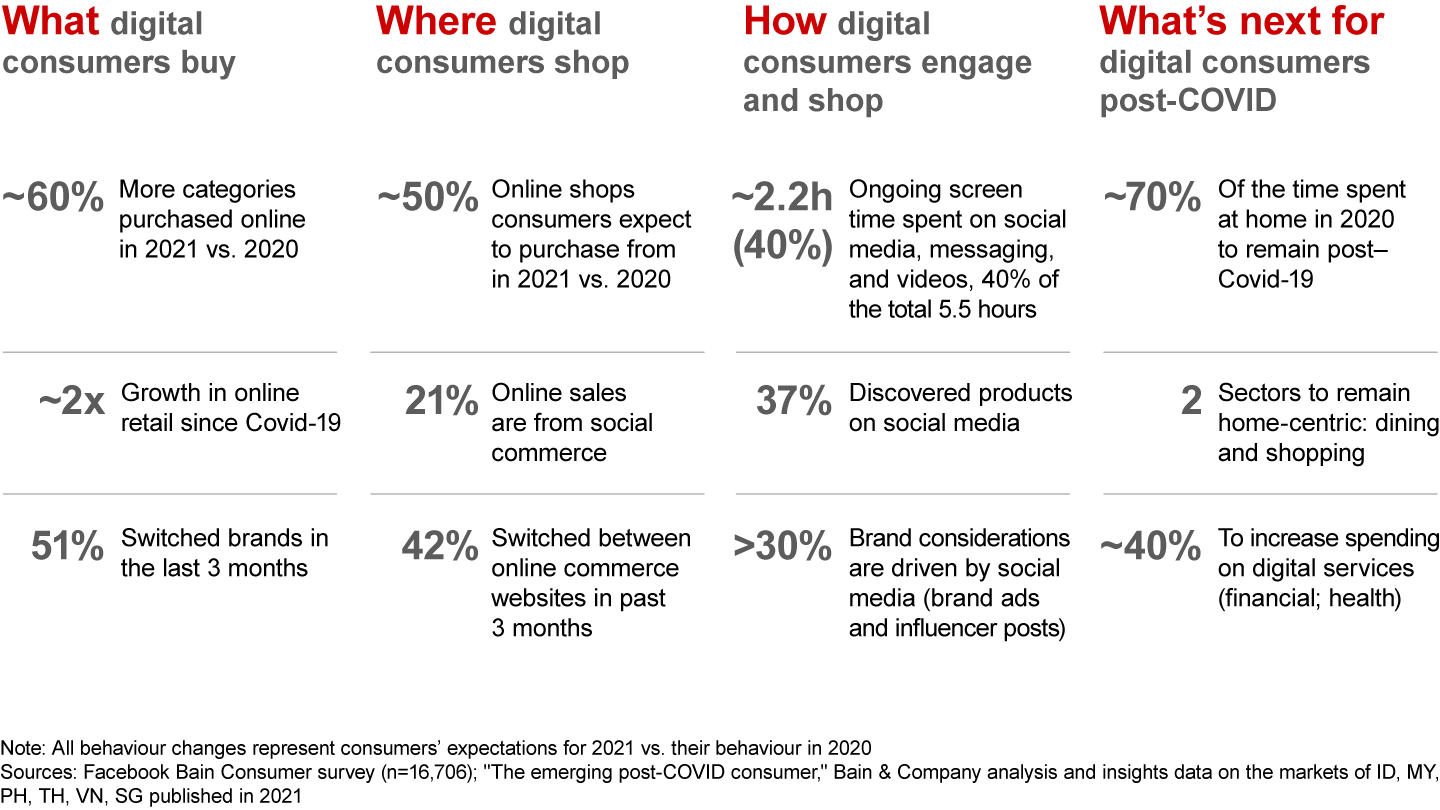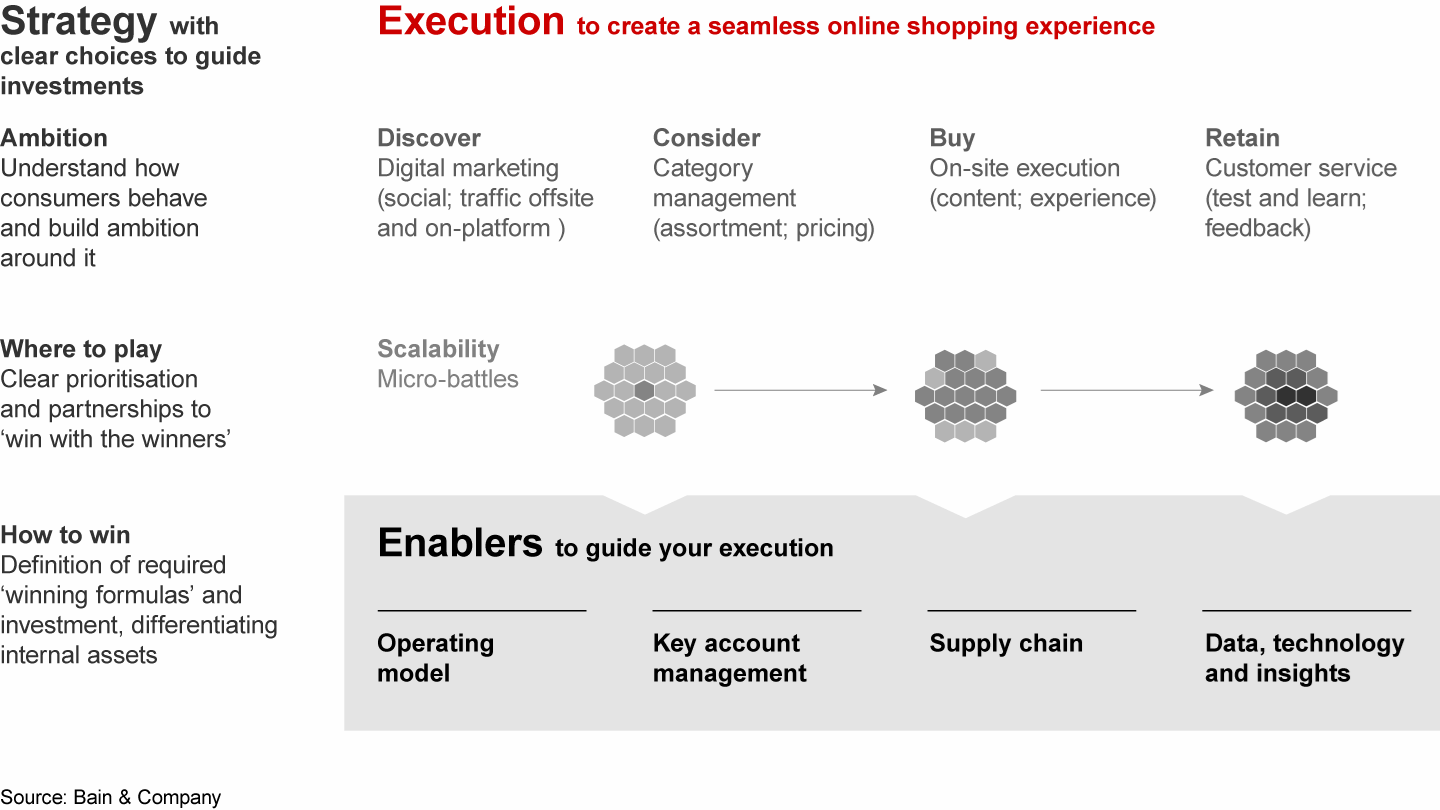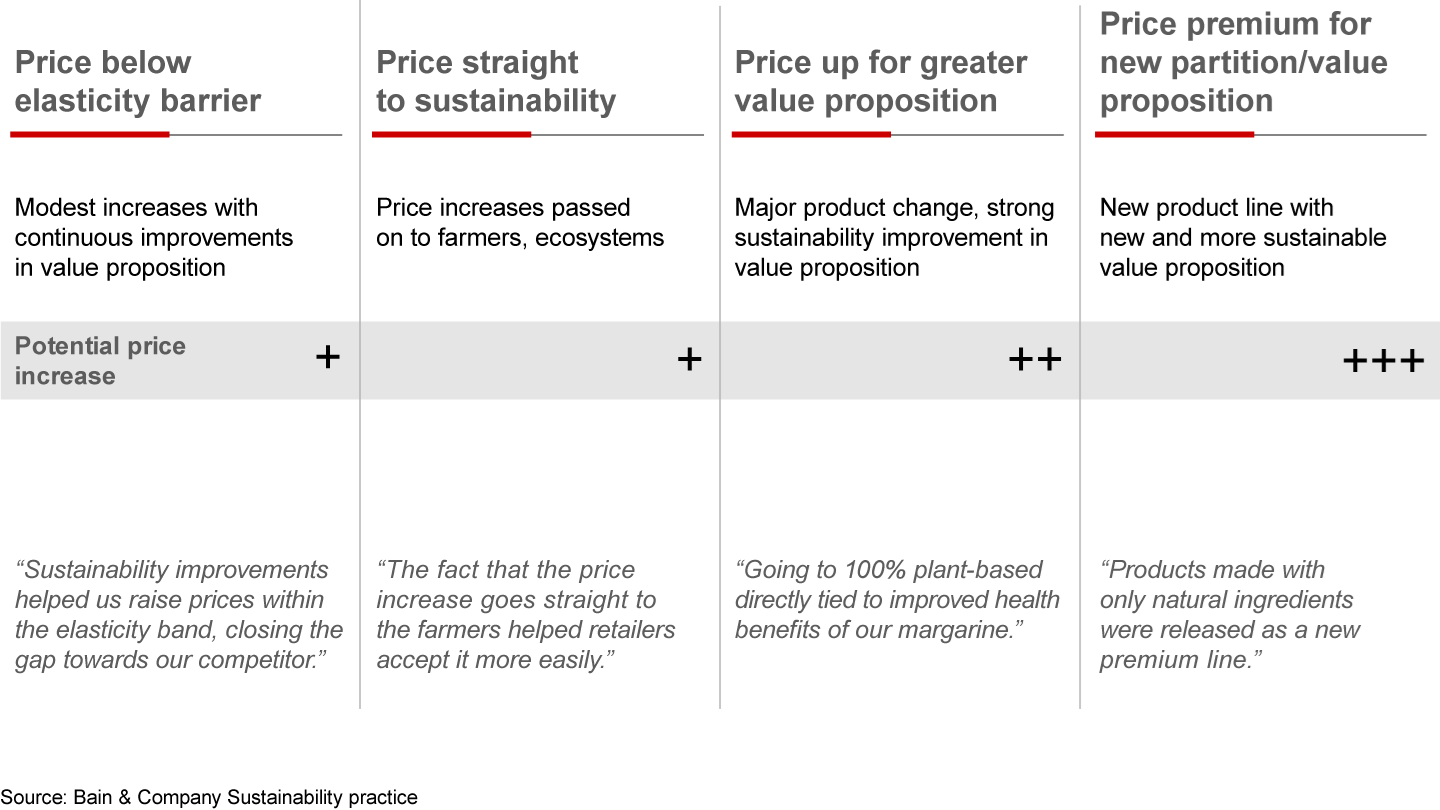Brief

Executive Summary
- With 350 million digital consumers, Southeast Asia is set to leapfrog China to become the fastest-growing digital economy in Asia-Pacific.
- The most successful brand owners and platforms will focus on strategies to both capitalise on a post-pandemic digital boom in the region and insulate themselves from ensuing digital disruptions.
- ‘Six Rs’ can help maximise your brand success: Rewrite your digital-first agenda, rewire your business model, reimagine consumer engagement, refresh product offerings, re-envision sustainability, and realign to consumers’ new hybrid lifestyle.
The moment has arrived for brands to take advantage of Southeast Asia’s (SEA’s) paradigm shift in consumer behaviours. Contribution of online retail to total retail for key categories is expected to reach 9% in 2021, compared with 5% in 2020.
Digital consumption in SEA is increasing faster than in other Asia-Pacific regions, according to research conducted by Bain & Company and Facebook. Digital shopping in SEA countries now outstrips China, at a 1.6x growth rate. In Southeast Asia, 78% of consumers are now digital consumers (those who performed a commercial transaction online). The number of new digital consumers added in one year in Singapore, Malaysia, Indonesia, the Philippines, Thailand, and Vietnam is equivalent to the population of the entire United Kingdom.

How the Pandemic Continues to Shape Consumer Behavior in Southeast Asia
Six consumer trends spurred by Covid-19 hold major business implications, according to a report by Facebook and Bain & Company.
Purchasing habits flipped as quickly as stay-at-home orders were executed. Savvy brands adjusted their marketing and sales operations in real time at the onset of the global Covid-19 pandemic to serve the surging digital population. Now, after more than a year of agile decision-making, these businesses are building strategies around the new post-pandemic customer profile.
What does that consumer look like? We identified durable post-pandemic trends in digital consumption—and six crucial strategies for companies and chief marketing officers to implement to take advantage of the Southeast Asian digital boom.
Post-pandemic consumer trends in Southeast Asia
Consumer behaviours changed dramatically with community lockdowns, brick-and-mortar store closures, and aversion to unnecessary outings. Predictably, digital shopping shot up for groceries, personal care, athleisure wear, and everything in between. Consumers formed new habits—some of which will transcend the pandemic to become permanent shifts in behaviour (see Figure 1).


In 2021, 35% more consumers are shopping mostly online compared to the previous year, our continuing survey with Facebook of nearly 17,000 consumers shows. The biggest online shopping spike is in the groceries sector, which was quickly energised by direct delivery services during the pandemic.
Not surprisingly, funds are aggressively flowing into the tech and Internet sector (88%) to fuel digital disruptions in areas like e-commerce and e-commerce enablers, edtech, medtech, and fintech. The race to disrupt existing business models is on. For retailers, there’s real urgency to invest ahead in a digital commerce operating model, and to develop new capabilities in consumer experience, logistics, talent, portfolio offering, technology, and data to be on the cutting edge. And because about 40% of consumers plan to spend more on digital services after the pandemic, we expect these investments in growth enablers to pay off.
The pandemic has permanently changed the buyer’s journey with the increase in screen time spent on digital shopping. In the new consumer omnichannel journey, online channels now play 4x the role of offline channels in brand discovery and evaluation. Social media is the top channel for brand discovery and consideration, with consumers expressing a preference for social videos. It’s a trend to take advantage of: 65% of shoppers don’t know what product they want to buy or where they want to buy from. Weaving a social video together with customer profile data—like what age they form brand loyalty or when they begin shopping for your products—gives you a powerful digital discovery strategy for targeting your spending on the right platform with the right parameters for success.
Great value continues to be a baseline criterion for 44% of SEA digital consumers. However, providing better quality is the key to driving a brand switch and subsequent repurchases. In addition, to differentiate and garner future loyalty, companies need to focus on positive buying experiences, value adds, and multi-point connections throughout a brand ecosystem.
Another factor leading consumers to drop a favourite brand for a new one is environmental, social, and governance (ESG) criteria. Increasingly, our research shows that environmentally and socially conscious customers who spend more time researching the brands they buy from are willing to put their money where their mouths are. For brands, an investment in better ESG operations, a robust sustainability strategy, and prominent marketing of their efforts can literally lead to brand adoption: 80% of SEA consumers are willing to pay a meaningful premium for brands whose practices align with their values.
With the prevalence of flexible and hybrid work models, a home-centric lifestyle is here to stay. With it, expect consumers to continue ordering dinner in and getting groceries delivered to their front door. While business travel is unlikely to return to its previous levels, do look for an increase in ‘workcations’ as employees take their laptops to remote locales once Covid-19 safety protocols are established for travel.
The ‘Six Rs’: Prioritise these steps for brand success with SEA digital consumers
With 70 million new digital consumers in SEA since the beginning of the pandemic, brands can’t afford to underestimate this market. The durable, digital-centric habits that consumers established in 2020 create a new consumer profile that you can use to anchor your business plans moving forward. These ‘Six Rs’—rewrite, rewire, reimagine, refresh, re-envision, and realign—define the path that brand owners and chief marketing officers need to take at this pivotal moment to capitalise on the growing SEA market.
Rewrite a digital-first agenda
Consumers have spent close to two years developing online buying and browsing habits. Those habits are firmly embedded and not about to change, influencing everything from how consumers hear about products to how they evaluate them against competitors and, ultimately, how they make purchases and develop brand loyalties.
The promise of digital leadership is clear—improved customer experience, loyalty, and market share. In fact, most insurgent brands tear down barriers set up by legacy brands in their route to market and avoid expensive TV reach by adopting a digital-first strategy: over-indexing on e-commerce channels and deploying targeted digital media, thereby reducing upfront investments and enabling speedy growth. Brands need to develop a holistic digital commerce strategy containing all the necessary building blocks and ensure a seamless consumer engagement (see Figures 2 and 3).




Rewire your business model
Disruptions to business models are happening 360° in every arena, and we don’t expect that to change. Instead of waiting for a moment of stability to make plans, brands should look at how they can adapt now—and how they can plan for future disruptions. The best way to tackle this is to start with a ‘future back’ approach.
Ask yourself these 11 questions:
- How is the ecosystem in which I play a role likely to evolve? What will be the competitive advantage of tomorrow for my industry?
- What are the emerging consumer cohorts that will increasingly shape the industry, and how will their preferences be different?
- Who are the competitors of tomorrow—especially those that don’t exist today, or are currently your partners but may eat into your profit pools?
- Is my route to market geared to a world in which online B2C and B2B will grow exponentially?
- Is my supply chain geared up for a localised or personalised offering?
- Are my business systems and processes agile enough to handle an unprecedented pace of change?
- Does my organisation have the necessary skillsets for the future?
- What roles are the regulators likely to play in my industry?
- What partnerships do I need to forge for asset-lite scaling?
- How will data, automation, and machine learning likely influence my value chain?
- How does sustainability and better corporate responsibility influence my future performance?
Reimagine consumer engagement
E-commerce platforms are increasingly used for searches. Social channels are increasingly used as points of sale. For digital consumers, while the proportion of end sales is still split between offline and online, our research shows that the role of digital channels far outweighs offline channels for brand discovery and consideration.
Common pitfalls we see here include ‘flying blind’ (low visibility on how much is spent and a ‘last-year+’ mindset about allocating commercial spending); not being ROI-driven; democratically allocating commercial spend across different sub-functions; and taking a siloed approach without understanding what touchpoints most influence the consumer’s path to purchase and how those touchpoints influence each other.
It is imperative for brands to independently reevaluate their commercial activities and re-orient their marketing and route-to-market spends to mirror this multichannel, multi-platform path to purchase. Today’s buyers are increasingly quick to switch brands and platforms. They expect a seamless experience from discovery to sale to delivery. Creating a unique, consistent, and engaging experience across your offline presence, social channels, website, and app establishes brand loyalty and differentiation for your consumers.
Finally, recognise that commercial operation levers are different for offline channels vs. e-commerce, hence the need to tweak your internal processes, such as Sales and Operational Planning, decision rights, dashboards and KPIs, and organisational structure. The talent in your commercial organisation needs to be well versed across all elements of the funnel vs. taking a legacy, siloed approach.
Refresh product offerings
Digital consumers shop across an average of 7.9 online websites or platforms—a 52% increase from 2020. Fifty-one percent of consumers say they switched from their most purchased brands in the past three months. Price wasn’t the only reason they switched: Better product quality, better availability, and faster delivery times all contributed to their decisions.
Consumers will increasingly demand ‘right for me, right now’ products, services, and experiences. On the other end of the spectrum, the Covid-19 pandemic will drive higher need for affordability. Brands will need to manage this polarisation while keeping their range simple, with easy-to-understand propositions and price points.
Re-envision the role of sustainability
When 80% of SEA consumers are willing to pay up to a 10% premium for eco-friendly and socially conscious products, sustainability needs to be the new normal—not just in consumer perception but in every aspect of the business, from product design to supply chain and operations.
Ensure that your brand has adequate ESG-focused options in your product range and proposition. It’s possible to transform the supply chain to improve sustainability without compromising on cost efficiencies (see Figure 4).


Remember, your consumers are willing to bankroll your environmentally and socially friendly practices. Make your sustainable practices explicit to capture a brand switch from SEA consumers.
Realign to the post-pandemic, hybrid lifestyle
Although the ‘new normal’ is still taking shape, we do know that flexible working arrangements that cut daily commutes, include less in-person office time, and encourage a more home-centric lifestyle are here to stay. Consumers want shopping options that keep them closer to home, especially in SEA countries with challenging transportation issues.
Your product offerings, marketing, and delivery options should cater to this new wave of homebodies. Redesign and customise a subset of your offerings especially for at-home consumption.
Digital SEA consumers are ready for you to accelerate
The Southeast Asian market has jumped to the top of the priority list for brands that want to take advantage of its strong e-commerce space. Long-lasting digital consumer trends that have emerged during the pandemic pave the way for immediate action. Implement the ‘Six Rs’ strategies to gain traction with these consumers—now and in the future.
This brief is part of a joint initiative from Bain & Company and Facebook. SYNC Southeast Asia is a thought-leadership series focused on the consumers of tomorrow. In this series, Bain & Company and Facebook will take business leaders through the emerging trends and rising opportunities that are shaping the vibrant region of Southeast Asia.